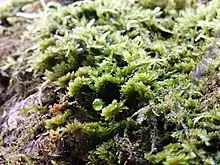Leptodontaceae
Leptodontaceae is a family of mosses belonging to the order Hypnales.[1] There are 3 genera with a worldwide distribution.
| Leptodontaceae | |
|---|---|
 | |
| Leptodon smithii | |
| Scientific classification | |
| Kingdom: | Plantae |
| Division: | Bryophyta |
| Class: | Bryopsida |
| Subclass: | Bryidae |
| Order: | Hypnales |
| Family: | Leptodontaceae Schimper, W.Ph., 1856. Corollarium Bryologiae Europaeae 98. |
Most of the genera of family Leptodontaceae, originally came from family Neckeraceae,[2] Such as Caduciella came into Leptodontaceae in 1991.[3]
It originally comprised Alsia, Forsstroemia, and Leptodon. Recently described or relocated genera in the family include Caduciella Enroth, Cryptoleptodon Renauld & Cardot, and Taiwanobryum Noguchi (J. Enroth 1992).[4] Molecular evidence indicates that this small family may not be monophyletic.[2][5]
Family Leucodontaceae now contain Forsstroemia and Alsia.[6] Although some sources note that they are back within the Neckeraceae family.[7] Later Cryptoleptodon moved into family Pterobryaceae,[8] and Taiwanobryum moved into family Prionodontaceae.[9]
Description
The plants are medium sized, forming loose tufts, dark green to yellow green. Corticolous (growing on bark) or saxicolous (growing on rock). The secondary stems are erect, sometimes incurved when dry and generally pinnately branched. The branches are in single plane, they have pseudoparaphyllia (the trichome-like or foliose structures on moss stem surfaces).[10]
They are defined by the combination of epiphytic habit, branching pattern of clusters of branches alternate with unbranched intervals bearing inflorescences, double sporophytic phenological cycle in which two cohorts of sporophytes mature simultaneously with embryos overwintering, subfoliose pseudoparaphyllia, cucullate calyptrae, sheathing post-fertilization perichaetial leaves (the leafy involucre surrounding the fruit stalk), central strands lacking in shoots, shortened setae (bristles), no annuli, and an exostome (the outer ring of peristome teeth) that flexes open when moist and flexes inward when dry (hydrocastique), thus serving to disperse spores during wet periods.[2]
Genera
- Caduciella Enroth (2)
- Leptodon D.Mohr (17)
- Pseudocryphaea E.G.Britton (1)
Figures in brackets are how many species per genus
References
- "Leptodontaceae". www.gbif.org. Retrieved 26 July 2022.
- Stark, Lloyd. "Leptodontaceae in Flora of North America @ efloras.org". www.efloras.org. Retrieved 26 July 2022.
- Enroth, Johannes (January 1991). "Notes on the Neckeraceae (Musci). 10. The taxonomic relationships of Pinnatella mariei , with the description of Caduciella (Leptodontaceae)". Journal of Bryology. 16 (4): 611–618. doi:10.1179/jbr.1991.16.4.611.
- Yoshinori Asakawa, Agnieszka Ludwiczuk and Fumihiro Nagashima Chemical Constituents of Bryophytes: Bio- and Chemical Diversity, Biological ... ( 2013), p. 15, at Google Books
- Ignatov M. S., Afonina O. M., Ignatova E. A. et al. 2006. Check-list of mosses of East Europe and North Asia. Arctoa. 15: 1–130. https://doi.org/10.15298/arctoa.15.01
- "Leucodontaceae". www.gbif.org. Retrieved 26 July 2022.
- Olsson, Sanna; Enroth, J.; Quandt, D. (1 June 2012). "Forsstroemia Lindb. (Neckeraceae) revisited". Journal of Bryology. 34: 114–122. doi:10.1179/1743282011Y.0000000047.
- "Pterobryaceae". www.gbif.org. Retrieved 26 July 2022.
- "Prionodontaceae". www.gbif.org. Retrieved 26 July 2022.
- Robert E. Magill Bryophyta: Mosses. fasc. 1. Sphagnaceae (1998), p. 585, at Google Books